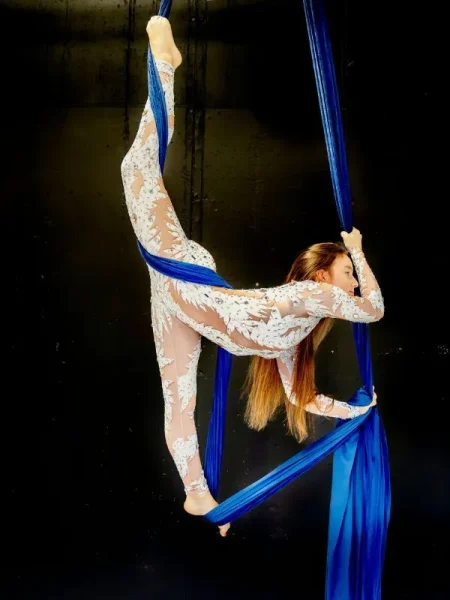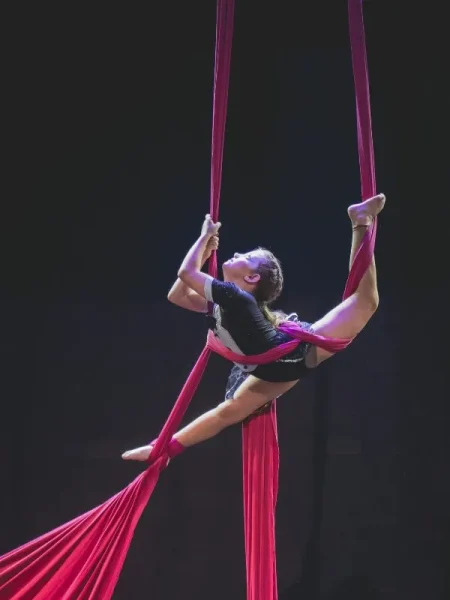Aerial Silks 101
Discover what they are, who they are for and why they are way more than just fabric in the air
What are Aerial Silks?
Picture this: two long pieces of fabric hanging from the ceiling, cascading down like a waterfall. Someone climbs up, wraps the material around their limbs, and suddenly – boom – they’re upside down, mid-air, spinning slowly like a dancer in slow motion. That’s aerial silks.
Aerial silks, also called aerial tissues or ribbons, are a type of performance apparatus used in aerial arts. Performers climb, twist, drop, pose and hang from the fabric – all using only their body and gravity. It’s beautiful. It’s intense. And honestly, it’s kind of addictive.
But here’s the thing: you don’t have to be a circus performer or ex-gymnast to start. These days, aerial silks are just as likely to be found in boutique fitness studios as they are at Cirque du Soleil.
Who Can Use Aerial Silks?
Let’s clear something up: aerial silks aren’t just for ultra-flexible acrobats or people born doing backflips. Not even close. You don’t need a certain body type to do aerial silks. You don’t need a background in movement. You just need a willingness to try… patience can help too!
They can be perfect for all sorts of people:
Beginners
Think of it like climbing meets dance meets strength training. It is definitely a workout, but it is also artistic and kind of meditative.
People Wanting Something Different
Maybe the gym feels stale. Maybe running hurts your knees. Maybe you’re just curious.
Fitness Folk
You’ll find yogis, climbers and even former CrossFitters trying it out for the sheer physicality of aerial silks.
Performers
Dancers, gymnasts and actors often train in aerial silks to expand their performance range.
Kids and Teens
Many studios offer classes for younger students. It’s a great mix of coordination, creativity and confidence-building. Plus it offers something different than what most of their friends are doing.
What Fabric are Aerial Silks Made From?
The “silks” themselves? They are not actually silk. That’s just a fancy name for them. They are usually made from a super-strong, slightly stretchy polyester or nylon blend. It has to hold your entire bodyweight – sometimes at speed – so durability isn’t optional.
Now, not all aerial silks are created equal. There are variations, and they matter more than you would think when you’re learning to wrap your first footlock.
1. Fabric Stretch Types
Aerial silks can be made from low, medium or high stretch fabrics. Each of these fabrics offer their own pros and cons.
Low-stretch (or no-stretch): Easier to climb and control. Perfect for beginners because the fabric doesn’t bounce around much.
Medium-stretch: Offers a little give, which is helpful for drops. Some people love the feeling – it’s a bit more dynamic.
High-stretch: Usually reserved for advanced artists or performance focused setups. It’s bouncy, responsive and harder to manage when you’re just starting out.
For more in-depth information on fabric stretch types, check out Aerial Silks Fabric: Understanding Stretch.
2. Fabric Width
Most silks are about 60″ wide when laid flat. Wider fabric offers more surface area for wraps and drops, and it tends to be gentler on the skin.
TIP: Narrower fabrics are easier to grip – especially for smaller hands or people who are still building up grip strength.
3. Fabric Length
Here’s where things get a little technical – but stick with me.
The general rule? The fabric needs to be at least twice the height of your rigging point, plus an extra couple of meters for wraps and tails. So if your ceiling is 6 meters high, you’ll want at least 14–15 meters of fabric.
At home, many people use rigs that are 3–5 meters tall. Studios and professional stages often go lots higher – sometimes up to 10 meters or more.



Rigging for Aerial Silks
No matter how strong or gorgeous the fabric is, it’s only as safe as whatever it is hanging from.
Rigging is the behind-the-scenes tech stuff that makes aerial arts possible – and safe. It includes hardware like:
– Carabiners
– Rescue 8s (the metal figure-8 used to tie the fabric on)
– Swivels (used to prevent tangling mid-spin)
– Slings or spansets (used to connect to ceiling beams or truss)
At home, rigging gets tricky. You need to be absolutely certain the mounting point can hold at least 10x your body weight – preferably more. A professionally installed rig or portable frame is a must. Random ceiling hooks? Please, no.
Studios use certified hardware and regularly inspect their gear. If you’re training somewhere new, it’s okay to ask about safety standards. Actually – it’s smart. Check out Aerial Rigging 101 for more information on rigging.
Basic Moves on the Aerial Silks
Yes, of course you will hang… but there’s so much more. Aerial silks blend climbing, wrapping, inverting, and dropping into one fluid language of movement. Every pose builds on the last.
Eventually, you’ll learn drops – where you let gravity do the work. They look terrifying but are actually safe (when taught correctly). And yes, the adrenaline rush is real.
Common Beginner Moves:
Footlock – You wrap one or both feet in the fabric to create a “step.” It’s the foundation for lots of poses.
Straddle Invert – Flipping upside down using core strength. It feels amazing once you get it – like a mini breakthrough.
Arabesque – A graceful pose with one leg extended behind, balancing on the silks, just beautiful.
Figure-8 Wraps – These keep you securely in place for poses or drops.
Climbs – Russian, French, straddle climbs… each style has a purpose and flair.
Do Aerial Silks Hurt?
The short (honest) answer: sometimes.
The long answer: You’re hanging your bodyweight from a thin piece of fabric. There will be pinching, pulling and some awkward pressure points. Your hands will ache at first. Your skin might bruise – especially behind your knees or under your arms.
But your body will adapt. Muscles get stronger, your skin gets tougher and better technique starts to make everything smoother.
Most people push through the first few weeks and come out the other side obsessed. It becomes less about “Is this painful?” and more like “Wait – I just did that?”
What You Need to Get Started With Aerial Silks
You don’t need much, but here’s a quick starter list:
– Comfortable clothing that covers your legs and underarms (to reduce fabric burn)
– Grippy socks or barefoot (personal choice – most people choose to go barefoot)
– Water and patience: Bring both
– Beginner-friendly studio: One with certified instructors and safe rigging
Thinking of training at home? You absolutely can but start in a studio first. Learn the basics, the safety cues and the “what not to do.” Then – maybe – consider a home aerial silks rig.
Why People Love the Aerial Silks and Why You Might Too
Honestly? Because it’s kind of magical.
It’s hard to explain what happens when your feet leave the ground and you realize you did that. Your arms pulled you up, your focus wrapped that fabric, your courage let you hang upside down and maybe even drop. It’s empowering in a way treadmills just… aren’t.
Plus, it is so creative. Every sequence is a mix of strength, timing, emotion and flow. You’re not just working out – you’re telling a story with your body. And you know what? It’s fun. Weird, sweaty, sometimes frustrating – but deeply fun.
If you’ve been eyeing those Instagram clips, wondering “Could I do that?”… you probably can. Not overnight. Not without some awkward flailing. But with the right class, a bit of grit and a sense of humor? I think you could surprise yourself.
So why not give it a shot. Worst case? You’ll get a killer grip and a new appreciation for gravity. Best case? You’ll find yourself somewhere between flying and falling – and loving every second of it.
